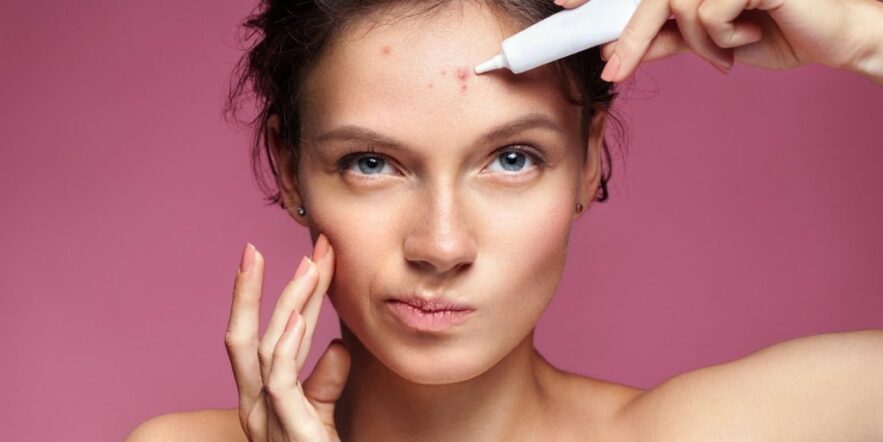As far back as the late 1800s, experts believed that diet could play a role in acne development. An 1885 study reported that chocolate, sugar and fat were the main culprits, so treatment routinely restricted those foods. But the thinking changed with a couple of late 1960s studies that refuted the association between diet and acne, and the idea became more of an old wives’ tale.
But in recent decades, once again research suggests that diet actually does contribute to improvement or worsening of acne. Dermatologists now think that changing the diet in specific (and healthy) ways should be considered as part of an overall prescribed acne treatment regimen.
Acne develops when hair follicles become clogged with hair, sebum (oil from sebaceous glands), and skin cells called keratinocytes. Clogged skin follicles are then infected by bacteria from the skin known as Cutibacterium acnes (formerly called Propionibacterium acnes), resulting in inflamed, reddened papules and pustules of acne.
Dermatologists typically prescribe topical acne treatments such as benzoyl peroxide or tretinoin (Retin-A) and isotretinoin (previously marketed as Accutane, an oral treatment prescribed for severe acne) to correct that buildup of skin cells and oil, but little heed has been given to the patient’s diet, says Whitney Bowe, MD, clinical assistant professor of dermatology at the Icahn School of Medicine at Mount Sinai in New York City.
“Newer research on acne suggests that inflammation [at the cellular level, known as oxidative stress], might come before and actually cause the other events leading to acne lesions,” Dr. Bowe says.
A review published in the Journal of Clinical and Aesthetic Dermatology presents a large body of evidence supporting the conclusion that acne is an inflammatory disease and that inflammation is a cause of the development of the early stages of acne lesions as well as the later stages, where inflammatory papules, pustules and nodules are present. A 2018 review of research in the journal Seminars in Cutaneous Medicine and Surgery concludes that inflammation plays a central role in acne development, with consumption of dairy foods and a high glycemic index diet as initiators.
This type of systemic inflammation has been linked to other skin conditions such as rosacea, eczema and psoriasis. In addition, inflammation in the body has been linked to the development of numerous chronic diseases such as heart disease, cancer, diabetes, and even chronic pain from conditions such as rheumatoid arthritis and osteoarthritis. We also know that inflammation can be influenced by diet, so the newest thinking is that an anti-inflammatory diet may have a positive effect on controlling acne.
Many dermatologists are adopting this more holistic (or whole-body) approach to acne treatment and have had success with it.
“Now I talk to patients about their diet, their exercise, their stress and suggest appropriate changes in addition to following a prescribed traditional topical and/or oral acne regimen. With this approach, I don’t feel the need to prescribe strong medications with dangerous side effects such as isotretinoin, also known as Accutane, says Debbie Palmer, DO, a dermatologist at Dermatology Associates in Harrison, N.Y. “Thirty days later, you can really tell which patients have changed their diet accordingly.”
Here are five research-based healthy ways you can change your diet to nip inflammation in the bud before acne pimples surface.
Browse This Article
Try Low-Glycemic
While we know that an anti-inflammatory diet is a low-glycemic diet rich in slowly digested carbohydrates, a few small studies have suggested that a low-glycemic diet can reduce the severity of acne. An Australian study of 23 males aged 15 to 25 who adhered to a strict 12-week low-glycemic diet had a marked improvement in acne severity.
In a study published in the journal Acta Dermato-Venereologica, 32 20- to 27-year-old Korean patients ate a low-glycemic diet for 10 weeks and also experienced a significant improvement in acne severity. The Korean authors also performed skin biopsies and found that in the low-glycemic diet group, the size of sebaceous glands and number of inflammatory cells was also decreased, while inflammatory substances secreted by cells that can negatively alter cell behavior and even cause cell DNA damage were also reduced.
Dr. Bowe, who co-authored Diet and acne update: Carbohydrates emerge as the main culprit, published in the Journal of Drugs and Dermatology, says, “We can see that the ingestion of high-glycemic foods triggers a cascade of endocrine responses that may trigger acne through androgens, growth hormones and cell-signaling pathways.” So she counsels acne patients about food’s potential to increase blood glucose and insulin and which foods are high and low on the glycemic index scale.
A 2017 study published in the Journal of the Academy of Nutrition and Dietetics, compared 5-day diets of 32 people with moderate to severe acne to diets of 32 people with no acne. Blood tests showed that people with acne had greater insulin resistance and concentrations of insulin-like growth factor-1, which is known to be a factor in acne progression. Food records of those with acne also reported a higher carbohydrate diet than people without acne. In a 2018 study by the same researchers, 34 people followed a low glycemic index diet while 32 people followed their usual eating plan for two weeks. At the end of the study, those on the low glycemic diet had reduced blood levels of insulin-like growth factor-1.
In her evidence-based book, Beyond Beauty, Dr. Palmer points to research which suggests that insulin plays a role in acne-causing the growth of pore-clogging cells, and increase in oil production and inflammatory mediators. Because of that, she advises patients to keep their blood sugar steady by following the glycemic index for choosing foods to eat.
“Glycemic index is a number that gives you an idea of how fast your body converts carbohydrates in specific foods to glucose,” Dr. Palmer says.” The smaller the number, the lower a food’s glycemic index, the slower it is absorbed, and the longer it stays in the bloodstream.” A glycemic index of 55 or less is low, 56 to 69 is a medium-glycemic food, and 70 or higher is a high-glycemic food.
Both doctors advise that acne patients avoid high-glycemic-index foods such as white bread, white pasta, white rice, pretzels, sugary snacks and drinks, and any white potatoes or potato products such as chips or fries. Instead, eat higher fiber content sweet potatoes, brown rice, whole-grain bread, beans, and nuts. (Want to check the foods you eat regularly? Here’s Oregon State’s handy glycemic index chart for 100 common foods.)
Add Antioxidants
Various studies have indicated oxidative stress contributes to the development of acne. For example, a study in the Annals of Clinical & Laboratory Science found higher levels of oxidative stress and lower antioxidant levels in acne patients compared to people without acne. And markers for oxidative stress were higher for people with severe acne compared to those with mild or moderate acne. A study in the journal Clinical and Experimental Dermatology found that plasma levels of antioxidant vitamins A and E were much lower in people with acne than in people without acne, and people with more severe acne had lower levels than people with milder acne.
Dr. Bowe also co-authored Acne Vulgaris: The Role of Oxidative Stress and the Potential Therapeutic Value of Local and Systemic Antioxidants, which was published in the Journal of Drugs and Dermatology. Some of the preliminary studies in humans were compelling, she says, although no large-scale clinical trials have shown that antioxidants might alter the course of acne.
Nonetheless, she encourages acne patients to up their intake of antioxidant-rich foods such as squash, berries and dark leafy greens rather than supplementing.
Dr. Palmer encourages her acne patients to eat more colorful fruits and vegetables such as carrots, cantaloupe, broccoli, alfalfa sprouts and purple grapes (with the seeds), all of which are filled with antioxidant vitamins A, C, E, and flavonoids. She also suggests acne patients add the green tea and antioxidant spices such as cinnamon and turmeric along with hot pepper (if you don’t have rosacea) to their food as much as possible.
“The closer to nature you eat them the better,” she says, favoring light steaming with a slight crunch and bright color as the hallmark of doneness instead of losing nutrients by frying or overcooking.
Ditch the Dairy
In previous studies of milk consumption and teenage acne in both girls and boys, researchers found in girls, acne was associated with all types of milk but in boys, acne was associated with skim milk consumption mostly. In a 2016 study involving 225 teenagers published in the Journal of the American Academy of Dermatology, the amount of low-fat or skim milk consumed by participants was significantly higher in those teens with acne.
In a 2018 analysis in the journal Nutrients, researchers reviewed data from 14 studies on the effect of dairy intake on acne in people aged 7 to 30. The studies included 23,046 people with acne and 55,483 without acne. Intake of any dairy at all — full-fat dairy, whole milk, low-fat milk, skim milk, yogurt — regardless of the number of servings or frequency of dairy intake, was associated with a higher risk for acne compared to no intake.
“While we still don’t know the exact mechanism by which milk causes acne’s cascade of events, whether it’s milk proteins, hormones, growth factors or the combination in dairy products, I do suggest acne patients steer clear of milk and try some low-glycemic-index dairy-free alternatives such as almond, soy, or coconut milk,” explains Dr. Bowe. “Look for varieties fortified with calcium and vitamin D, and eat more leafy greens high in calcium such as kale and broccoli, to keep a calcium deficiency at bay, she advises.
Use Probiotics
In the early 20th century dermatologists began to recognize a gastrointestinal and psychological influence on acne, suggesting that emotional states like depression and anxiety could lead to changes in the balance of bacteria (microflora) in the intestines, triggering a cascade of events resulting in systemic and local skin inflammation. Over the years, research has supported the existence of a gut-brain–skin axis that connects psychological distress, gut microbes, oral probiotics, and diet, to acne severity.
A typical high-fat, low-fiber Western diet, including red meat, dairy, and foods with a high glycemic index, is thought to aggravate acne by altering intestinal microflora and increasing insulin resistance. “In those susceptible to acne, we think this cascade negatively influences the skin and potentially exacerbates acne,” explains Dr. Bowe. “Oral probiotics have been shown to regulate the release of inflammatory substances within the skin and improve insulin sensitivity,” she says.
A 2013 study testing whether coupling a probiotic with an antibiotic for the treatment of inflammatory acne found a significant decrease in total acne lesion count in the group that received both the probiotic and the antibiotic minocycline. The probiotic also helped avoid other side effects of long-term antibiotic use for controlling acne.
A 2020 review of current research on the prevention and treatment of acne and other skin diseases supported the use of probiotics. Reporting in the British Journal of Dermatology, researchers concluded that clinical trial data supported the role of the gut and skin microflora in dermatology, citing multiple studies showing improvements in acne with the use of oral probiotics.
Dr. Palmer says the research on the gut and disease also shows that a lack of diversity and fresh plant foods in the typical American diet leads to a lack of diversity in gut microbes which in turn leads to systemic inflammation and the cascade of effects, including acne. Along with taking a probiotic supplement, Dr. Palmer advises her patients to increase their intake of fresh fruits, vegetables, grains, beans, and nuts to improve the gut microbiome for overall long-term health as well as for the treatment of their acne.
Find Omegas
Omega-3 fatty acids (EPA and DHA) contained in fish oil and some plant and nut oils suppress inflammation in the body, while omega-6 fatty acids — found in sunflower and palm oils, for example — increase inflammation in the body when eaten in abundance. Some foods high in omega-6 fatty acids include fatty red meat, fried poultry, and pork products, eggs and dairy products, vegetable oils (canola oil, safflower oil, corn oil, and vegetable oil) as well as fast food, processed snack foods and sweets made with these oils. A 2020 study notes that the omega 6: omega-3 intake ratio in typical Western diets is 15/1 to 16.7/1, but the ideal ratio for humans is 1:1 up to 4:1.
A small study in the journal Lipids in Health and Disease found that supplementing with fish oil for 12 weeks improved moderate to severe acne, but not mild acne.
“I explain to my acne patients that the relative intake of omega-6 to omega-3 polyunsaturated fatty acids appears to be an important modulator of inflammation. Eating foods rich in omega-3 fatty acids or taking fish oil supplements with 1,000 to 2,000 mg per day of EPA might benefit their acne,” says Dr. Bowe.
Dr. Palmer agrees and suggests that her acne patients add lots of naturally occurring Omega-3s from avocados, salmon, and flaxseed oil to their diets.
“Instead of crunching chips, choose crunchy nuts such as almonds, pistachios, and walnuts (without artificial flavorings other than salt), which also provide important minerals such as selenium and zinc,” she says, because, “Studies have found them lacking in acne patients.”
While topical treatments can help control acne breakouts, certain diet tweaks can help as well and they may cost less, aid your nutrition and prevent any troublesome side effects and improve your skin and overall health for the long term.







